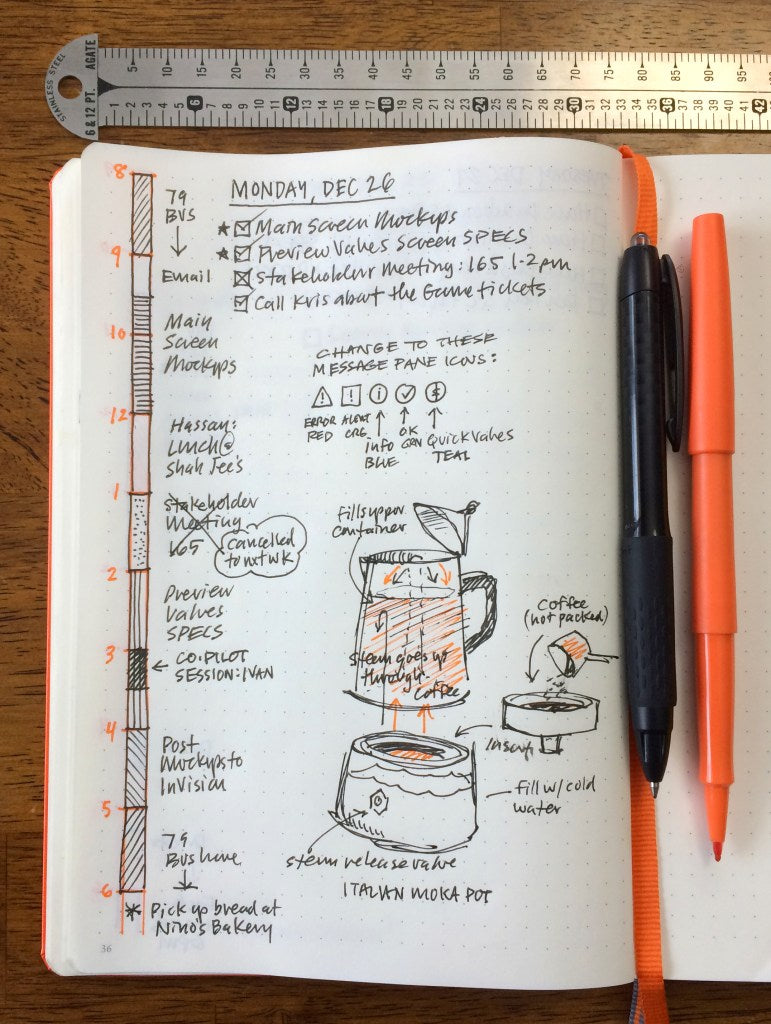One of the first few things that I discovered when I was starting out with my Bullet Journal journey was Mike Rohde‘s Daily Plan Bar. I really loved the concept and also loved the way his pages turned out.
Hoever, I wasn’t able to use this method because relied on my digital calendar for meetings. I was also hesitant because of the potential amount of space that it took on an A5 notebook.

A few weeks ago, I found myself unable to balance my work schedule efficiently and using my bullet journal less again. I had already started blocking 2 hours of my work day to focus on important tasks. Despite that, I found myself unable to completely focus during my focus time. Then, I remembered the Daily Plan Bar concept.
There are a lot of time tracking techniques to incorporate with the Bullet Journal but the Plan Bar seemed to be the best for me. It was an excellent way to help me improve on my time management skills without digital tools. I tried the system for a month and here are a few things that I learned when I was using this system.
Allot a few minutes beforehand to prepare the Daily Plan Bar
There is a bit of “setup” required when using the daily plan bar. Make sure that you take some time in the day or maybe the weekend to set up the weekly plan bar for the next couple of days. It won’t take long. But if you’re rushing to get your day started (e.g. you woke up late but just in time for a meeting), you might not have enough time to get the Daily Plan Bar setup.
A page a day
If you use the actual format of the Daily Plan Bar, expect to use one page a day. You won’t be able to fill the page with tasks all the time, that’s for sure. However, the way it’s designed demands vertical space. Expect that with this design, you will use one page a day. The same design is practiced by Hobonichi planners which feature time trackers as well.
It doesn’t have to take up the entire space though. In one of the older versions of the Daily Plan Bar (which Rodhe credited this idea to), the time ladder/bar took a small spot on the side of the page. This would definitely vary with the bullet journalist’s handwriting size and style.
What to include in the Daily Plan Bar
The basic purpose of the the Daily Plan bar is to plot meetings or appointments. However, it isn’t only limited to that but this also is a great way to track your activities.

I personally use the Daily Plan Bar to block off my calendar so that I can plot hours for focusing. A typical work day for me consists of whole day meetings. Once I plot them into the Daily Plan Bar, I can easily see where I can slot in times when I can focus solely on my work rather than listening in on meetings.
You don’t always have to use it
I used the Daily Plan Bar for a month but when September came rolling in, I decided to stop using it because it started to get redundant. Although the routine and redundancy doesn’t bother me as much but I found that the amount of time spend on setting up the plan bar wasn’t worth it for recurring meetings. The past few weeks have also been a bit at home so sticking to a 9-5 schedule at work was nearly impossible.
Just like any other collection in the Bullet Journal, you can change whenever you need to. You don’t have to stick with one process all throughout the year, month, or even the week. This, once again, is one of the greatest things about the Bullet Journal Method.
Read: Why It’s Important to Experiment in your Bullet Journal
When to use?
The purpose of the plan bar is pretty apparent. At first glance, it’s a daily calendar – a place where you can track appointments or meetings. On the other hand, it serves a time management tool that aids in time-boxing (or time blocking for some). This is a great supplement to the Bullet Journal Method because it can work alongside the practice of bullet journaling as well.
Learn More abut the Daily Plan Bar
Read more on the Plan Bar and the step-by-step guide here

Amazon Disclosure
Rediscover Analog is a participant in the Amazon Services LLC Associates Program, an affiliate advertising program designed to provide a means for sites to earn advertising fees by advertising and linking to Amazon.com








